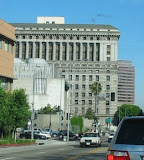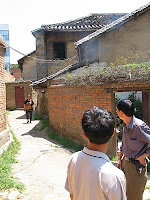Great Earthquakes I Have Known: Quake #1, San Fernando (Sylmar) 1971
Monday, March 03, 2008
After I wrote about all the earthquake activity around Guadalupe Victoria, Baja California (which had another 5.0 the next afternoon), Caedmonstia asked, “How big does an earthquake have to be for people to feel it?” Someplace, I’m sure there are wonderful scientific answers to that, such as, “It depends.” But I am thinking more experientially. In this new series, I will be describing the Standout Moments of My Personal Seismological Memory:
San Fernando, California, Feb, 9, 1971, 6:01 a.m., (6.6 on the Richter scale). I was about twenty miles away, on the 5th floor of a UCLA dorm building. It woke me up with the thought that a railroad train was coming through the bedroom. Those who were coherent enough to run to the windows reported seeing a wave of green explosions as transformers went dead across the still-dark city. Sixty five people died in the earthquake (most in one hospital that collapsed). The quake was much worse at my parents' house (a freestanding cabinet fell across my sister and her bed), only about ten miles from the epicenter and downstream from a large earthen dam. For me, it was the only time I ever remember everybody being awake and in line for breakfast when the dining hall opened at 7:00. But for what? Classes were canceled. I had been tutoring ESL at Castelar Elementary School in Chinatown, but the main building was sufficiently cracked that it could never be used again. A mile south of that was the Hall of Justice, which included both the DA’s and Sheriff’s offices, courtrooms, and several floors of jail. It also suffered damage and had to be evacuated and boarded up. It still stands empty, today. That made it difficult for me to research it when I wanted to use it as a location for my novel, Friday 10:03. Eventually, I talked to my father's cousin who had worked there, and it became one of my favorite locales in the book.





